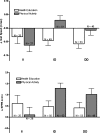Genetic influence on exercise-induced changes in physical function among mobility-limited older adults
- PMID: 24423970
- PMCID: PMC3949106
- DOI: 10.1152/physiolgenomics.00169.2013
Genetic influence on exercise-induced changes in physical function among mobility-limited older adults
Abstract
To date, physical exercise is the only intervention consistently demonstrated to attenuate age-related declines in physical function. However, variability exists in seniors' responsiveness to training. One potential source of variability is the insertion (I allele) or deletion (D allele) of a 287 bp fragment in intron 16 of the angiotensin-converting enzyme (ACE) gene. This polymorphism is known to influence a variety of physiological adaptions to exercise. However, evidence is inconclusive regarding the influence of this polymorphism on older adults' functional responses to exercise. This study aimed to evaluate the association of ACE I/D genotypes with changes in physical function among Caucasian older adults (n = 283) following 12 mo of either structured, multimodal physical activity or health education. Measures of physical function included usual-paced gait speed and performance on the Short Physical Performance Battery (SPPB). After checking Hardy-Weinberg equilibrium, we used using linear regression to evaluate the genotype*treatment interaction for each outcome. Covariates included clinic site, body mass index, age, sex, baseline score, comorbidity, and use of angiotensin receptor blockers or ACE inhibitors. Genotype frequencies [II (19.4%), ID (42.4%), DD (38.2%)] were in Hardy-Weinberg equilibrium (P > 0.05). The genotype*treatment interaction was statistically significant for both gait speed (P = 0.002) and SPPB (P = 0.020). Exercise improved gait speed by 0.06 ± 0.01 m/sec and SPPB score by 0.72 ± 0.16 points among those with at least one D allele (ID/DD carriers), but function was not improved among II carriers. Thus, ACE I/D genotype appears to play a role in modulating functional responses to exercise training in seniors.
Keywords: ACE gene; aging; disability; exercise; genetics.
Figures





References
-
- Afilalo J, Eisenberg MJ, Morin JF, Bergman H, Monette J, Noiseux N, Perrault LP, Alexander KP, Langlois Y, Dendukuri N, Chamoun P, Kasparian G, Robichaud S, Gharacholou SM, Boivin JF. Gait speed as an incremental predictor of mortality and major morbidity in elderly patients undergoing cardiac surgery. J Am Coll Cardiol 56: 1668–1676, 2010 - PubMed
-
- Agerholm-Larsen B, Tybjaerg-Hansen A, Schnohr P, Nordestgaard BG. ACE gene polymorphism explains 30–40% of variability in serum ACE activity in both women and men in the population at large: the Copenhagen City Heart Study. Atherosclerosis 147: 425–427, 1999 - PubMed
-
- American College of Sports Medicine, Chodzko-Zajko WJ, Proctor DN, Fiatarone Singh MA, Minson CT, Nigg CR, Salem GJ, Skinner JS. American College of Sports Medicine position stand. Exercise and physical activity for older adults. Med Sci Sports Exerc 41: 1510–1530, 2009 - PubMed
-
- American Geriatrics Society Panel on Exercise and Osteoarthritis Exercise prescription for older adults with osteoarthritis pain: consensus practice recommendations. A supplement to the AGS Clinical Practice Guidelines on the management of chronic pain in older adults. J Am Geriatr Soc 49: 808–823, 2001 - PubMed
-
- Aronow WS. Treating hypertension in older adults: safety considerations. Drug Saf 32: 111–118, 2009 - PubMed
Publication types
MeSH terms
Substances
Grants and funding
LinkOut - more resources
Full Text Sources
Other Literature Sources
Medical
Miscellaneous

